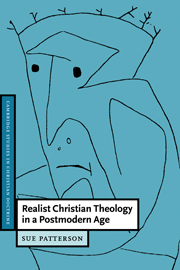Book contents
- Frontmatter
- Contents
- Acknowledgements
- Introduction
- 1 The task of theological realism
- 2 The dilemma of postliberal theology
- 3 Interpreting the truth
- 4 The anatomy of language-riddenness
- 5 The nature of theistic realism
- 6 Becoming persons
- 7 Becoming the Church
- Conclusion
- Select bibliography
- Index of names
- Index of subjects
2 - The dilemma of postliberal theology
Published online by Cambridge University Press: 02 December 2009
- Frontmatter
- Contents
- Acknowledgements
- Introduction
- 1 The task of theological realism
- 2 The dilemma of postliberal theology
- 3 Interpreting the truth
- 4 The anatomy of language-riddenness
- 5 The nature of theistic realism
- 6 Becoming persons
- 7 Becoming the Church
- Conclusion
- Select bibliography
- Index of names
- Index of subjects
Summary
In the last chapter it was suggested that an internal-realist model of a Putnamian kind may find a place within a theistic realism. The question was raised at the end of the chapter whether such a model could accommodate a postmodern linguistic element within the theistic framework.
The postliberal proposal
In attempting to follow the perilous path of postmodernity without leading Christian theology into the wilderness, postliberal theology has faced the challenge of reconciling a biblical theology with a world in which all human reality comes historically and contextually shaped and human beings are constituted as persons in relation to a particular inherited communal reality. In maintaining the priority of first-order language in biblical narrative and Christian practice over propositional knowledge and experience and suggesting an alternative ‘cultural-linguistic model’, it aims to put a combination of Wittgensteinian models and Geertzian ‘thick description’ ethnography in place of traditionalrealist and phenomenological assumptions.
In The Nature of Doctrine, George Lindbeck suggests a cultural-linguistic model as the framework for a ‘common denominator’ theory that will enable interfaith dialogue. This means, importantly, that his discussion context is initially the pre-theological one of theories of religion rather than Christian theology as such. The cultural-linguistic perspective is advanced as an alternative to the prevalent ‘cognitivepropositional’ and ‘experiential-expressivist’ perspectives which Lindbeck considers have hindered or inadequately served this dialogue. This alternative is attractive because it does not deal in the truth claims or expressive symbols (respectively) peculiar to a given religion. From the viewpoint of this model, becoming religious is like learning a language or acquiring a culture.
- Type
- Chapter
- Information
- Realist Christian Theology in a Postmodern Age , pp. 33 - 52Publisher: Cambridge University PressPrint publication year: 1999

